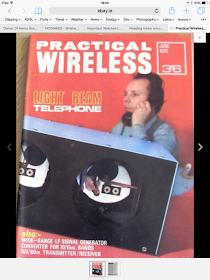Hi Bill,
Reading about the Photophone and modulating the Sun experiments by G3ZPF reminded me of my own schooldays when as a final year physics project I think in 1970, I and another pupil built a light modulated telephone based on a design published in Practical Wireless of June 1970 by J. Thornton Lawrence. For the optical system it used a pair of spherical mirrors from old projection televisions. The detector was the expensive (for a school kid) OCP71 photo transistor, though we did also try ordinary less expensive OC71 transistors with the black paint scraped off with less success.
As David G3ZPF noted the problem with filament bulbs was the thermal inertia, and as I found it was also possible for the filament to mechanically resonate in the wooden box and start to howl. As we had never heard of, nor could have afforded an LED, we tried a Neon bulb run from an HT battery and modulated with a transformer in series with it. I recall coupling up a broadcast radio as the audio source playing "My Sweet Lord" by George Harrison and receiving it at the other end of the physics corridor very loud and clear on the audio amplifier on our light telephone receiver, much to the consternation and annoyance of the other teachers in the adjacent classrooms.
I found my black and white photo of the light telephone gear, complete with carbon telephone microphone that we used. It did work a fairly good distance in daylight outside across the school playground, not just the couple of feet shown. Also attached are photos of the original magazine cover and index, but regrettably not the article itself.
This was all before I got my ham ticket, but I already was a SWL and had been exposed to a wonderful ham, Tom GM3OWI (Oh Wild Indians) who visited the school and demonstrated all sorts of neat stuff like lighting a bulb from the output of a transmitter, and also voice modulating a klystron 3cm transmitter that the school had for doing electromagnetic radiation experiments, like polarisation, reflection etc.
Come to think of it, we got to play with a lot of stuff at school in those days which would never be allowed now, mercury, radioactive sources, alpha, beta and gamma, X-Ray and UV. The museum in Edinburgh also had a science area with similar stuff you could play with, and get great shocks from the Van der Graff generator if you put your hand on the glass cabinet and touched the adjacent metal radiator!
Happy days!
73 David Anderson GM4JJJ

I found the explanation of why OC71 with the black paint scraped off would not likely work on: http://www.wylie.org.uk/technology/semics/Mullard/Mullard.htm
ReplyDelete"Like other manufacturers, Mullard produced a phototransistor, the OCP71 shown on the left. This is a very early type, available commercially from 1956. It is well-known that semiconductor junctions can be light-sensitive, and there is a widely repeated story that the OCP71 was just an ordinary OC71 without the black paint ('dope'). Because the OCP71 was more expensive, some people just scraped the paint off an OC71, to create an equivalent to the OCP71. The story then claims that Mullard changed the filler in the capsules from clear to opaque, to prevent this practice.
Thanks to correspondence with an ex-Mullard employee from the Mitcham works, I now know that this story is entirely wrong. At the time, the behaviour of manufactured transistors varied considerably, so devices from one source were sorted into either OC70, OC71, or OC75 using a Transistor Test Board. These transistors were filled with Alundum paste: an aluminium oxide and silicon oil mix that made them lightproof and also conducted the heat away from the transistor junctions. The devices were dipped in a light blue silicon "Bouncing" putty before putting them into the Alundum filled envelope, and scraping off the black 'dope' often reveals a blue tinged whitish interior. However, the OCP71 capsules were filled with a clear silicon grease to allow light through. They were tested as phototransistors and those that were rejected were re-tested to see if they met the normal OC series parameters. Those that did were sent off to be painted with the black dope and be printed as OC devices before being packaged as normal. Therefore, if scraping the paint off an OC71 reveals a transparent interior, this is NOT an early example before Mullard switched he filler, but is in fact a rejected OCP71. This defeats the whole point of the paint-scraping process!"
Please visit the above site for much more interesting stuff on early transistors.
73
David Anderson GM4JJJ